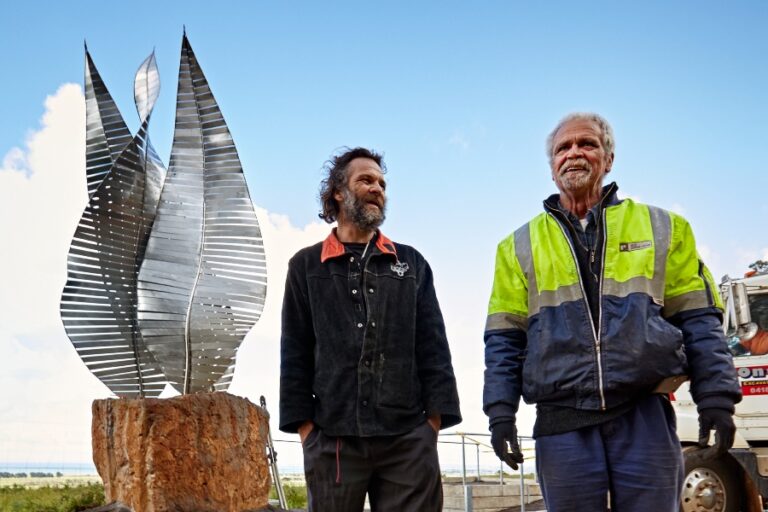A new report showcases community truth-telling changing narratives of our shared history. Such is the case with Mayapa Weeyn, a sculpture that has created a conversation in Portland, Victoria about who and what we commemorate.
Gunditjmara Original Custodian Walter Saunders created Mayapa Weeyn and co-authored this story.
Truth-telling moments are a way to bring people together over shared histories. They begin as an invitation: a chance to learn and experience stories through a local cultural lens. But the power of truth-telling doesn’t end there. Often a process is sparked – one that can change a whole community’s view on their past and impact their future.
The Convincing Ground massacre is the name given to the first major recorded massacre in Victoria. It happened on the coast at Allestree on the coast of Kardermudelar (Portland Bay), roughly 10 km from the town of Portland, now the Shire of Glenelg in southwestern Victoria.
Approximately 60 members of the Gunditjmara Tribe were killed in a dispute over ownership of a beached whale. Only two members of the clans survived the massacre.
In 2005, members of the Aboriginal community, through their Cultural Heritage Officer, halted bulldozing and development work at the Convincing Ground site. The community, including Walter Saunders, heavily advocated for the sacred site. Their advocacy convinced the Victorian Civil Administrative Tribunal, and it was agreed the site would be set aside as a reserve.

A new kind of monument
Walter’s truth-telling advocacy didn’t end there. Throughout the area there are statues of early settlers permanently promoting the ‘heroic’ colonial past, Walter set about creating a monument to his people to contrast this imperial narrative.
The Cart Gunditj and all 59 clans of the Dhauwurd Wurrung are commemorated in Walter’s statue, Mayapa Weeyn (make fire). It symbolises the signal fires the Cart Gunditj lit to alert other clans when whales beached. Even though these events were noted in historical diaries and journals, Walter’s story through the sculpture became an accessible way to have a conversation, sometimes in unexpected ways.
‘I had to design the sculpture, buy the stainless steel and weld the five-metre-tall sculpture in my shed,’ Walter says.
I had to get it cut out by the laser cutters, purchase fasteners and welding rods. All of the shopkeepers and other people involved in that process knew the story and said, “Congratulations, it’s about time the story was told.”
Walter erected the sculpture in 2018 at Whaler’s Lookout on Cart Mountain. With Mayapa Weeyn firmly embedded physically in the town, Walter continues to tell stories to residents and tourists about Convincing Ground. It’s an ongoing conversation inspiring others to share truths in response. During a talk at the local library, a resident revealed to him: ‘My family killed an Aboriginal person and they threw him in the well, and then we filled up the well, and I know where the well is, Wal.’
The conversation continues
The community is taking ownership of this shared history, restoring the site itself as a reflective area. The Gunditj Mirring corporation won a $30K grant in 2020 and set about cleaning up the site, replacing weeds with native plants. They plan for it to be a place for learning the full history of the site and to ‘contemplate a healing future’.
While these plans are underway, an annual smoking ceremony has been taking place at the site on 26 January, led by Gunditjmara man, Chris Saunders. Over a few years the small number of attendees grew to a crowd of 300.
At first, it was just family and Elders … But now, it’s shifted to include the wider community, which we wanted to see all along.
Chris Saunders
A private ceremony for Traditional Owners is held at dawn beforehand. Later in the morning, another smoking ceremony takes place for the wider community at ‘the Ploughed Ground’ in Portland.
This area is claimed to be the spot where the Henty family first ploughed the land, ‘introducing’ European farming to Victoria. A memorial stone stands ‘in commemoration of the discovery of Portland Bay by Lt James Grant’ in 1800. However, there’s evidence of Gunditjmara people cultivating the land well before settlers arrived.
A shared story and steps forward together
With truth-telling spreading through the community through experiential and informal processes, the communityis inspired to know more. They’re questioning what’s around them, and what to do about it.
Two years after Mayapa Weeyn was installed, local Gunditjmara resident Shea Rotumah called for the council to assess their stance on the colonial monuments. The mayor committed to auditing the monuments and better understanding their significance.
As the community explores its history more deeply, Walter points out that people must be appropriately supported to meaningfully participate in community truth-telling, should they wish to do so. He also emphasises it’s about embedding agency and sovereignty rather than victimhood.
Over the decades of truth-telling for this community (so far), discussion has moved away from a debate about whether a massacre happened or how many people died. It has become about increasing recognition of and respect for the significance of these events for Gunditjmara people.
People are taking more initiative to learn truths in histories, knowing more about their effects on Aboriginal people and the community.
They’re being proactive, sharing the commemoration event through advertising in the community and on Facebook. For this coastal Victorian community, it’s a step forwards together – to better understanding and eventual reconciliation.
The Recognising community truth-telling: An exploration of local truth-telling in Australia report documents 25 community truth-telling projects, including 10 in-depth case studies. Read the full report.
See more of Deakin University’s Alfred Deakin Institute for Citizenship and Globalisation’s research: deakin.edu.au/adi
This article is from the 50th edition of Reconciliation News magazine. Read the rest of the issue.



